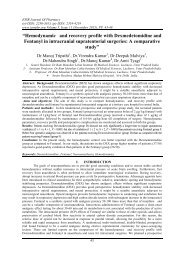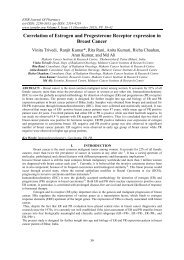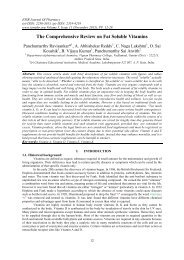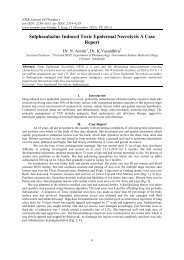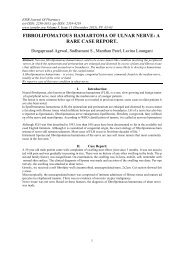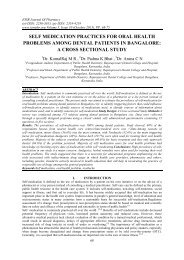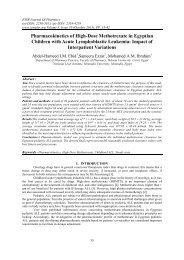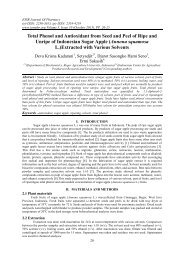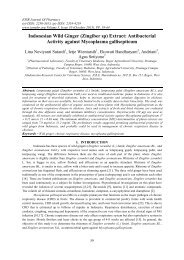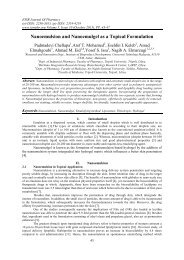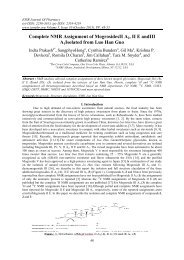Evaluation the efficacy of IVIgG in treatment of Hemolytic Disease of Newborn
Hemolytic disease of newborn (HDN) is an important cause of hyperbilirubinemia in the neonatal period,and delayed diagnosis and treatment may lead to permanent brain damage. Traditional neonatal treatment of HDN is intensive phototherapy and exchange transfusion.Intravenous immunoglobulin(IVIgG) has been introduced as an alternative therapy to exchange transfusion. This study was conducted to assess the effect of IVIG in HDN .
Hemolytic disease of newborn (HDN) is an important cause of hyperbilirubinemia in the neonatal period,and delayed diagnosis and treatment may lead to permanent brain damage. Traditional
neonatal treatment of HDN is intensive phototherapy and exchange transfusion.Intravenous immunoglobulin(IVIgG) has been introduced as an alternative therapy to exchange transfusion. This study was
conducted to assess the effect of IVIG in HDN .
You also want an ePaper? Increase the reach of your titles
YUMPU automatically turns print PDFs into web optimized ePapers that Google loves.
IOSR Journal Of Pharmacy<br />
(e)-ISSN: 2250-3013, (p)-ISSN: 2319-4219<br />
www.iosrphr.org Volume 5, Issue 11 (November 2015), PP. 04-08<br />
<strong>Evaluation</strong> <strong>the</strong> <strong>efficacy</strong> <strong>of</strong> <strong>IVIgG</strong> <strong>in</strong> <strong>treatment</strong> <strong>of</strong> <strong>Hemolytic</strong><br />
<strong>Disease</strong> <strong>of</strong> <strong>Newborn</strong><br />
M<strong>in</strong>oo fallahi 1 , Seyed Hosse<strong>in</strong> Fakhraee 2 ,Mohammad Kazemian 3 ,<br />
Farid Aleali 4<br />
1. Assistant pr<strong>of</strong>essor <strong>of</strong> Shahid Beheshti Medical University <strong>of</strong> Science , Neonatal Health Research<br />
Center(NHRC).M<strong>of</strong>id Hospital<br />
2 Pr<strong>of</strong>essr <strong>of</strong> Shahid Beheshti Medical University <strong>of</strong> Science , Neonatal Health Research Center(NHRC).M<strong>of</strong>id<br />
Hospital, M<strong>of</strong>id Hospital<br />
3. Associated <strong>of</strong> Shahid Beheshti Medical University <strong>of</strong> Science , Neonatal Health Research Center(NHRC).M<strong>of</strong>id<br />
Hospital, M<strong>of</strong>id Hospital<br />
4. Neonatalogy and Per<strong>in</strong>atology Felowship <strong>of</strong> Shahid Beheshti Medical University <strong>of</strong> Science, M<strong>of</strong>id Hospital<br />
Abstract:<br />
Background: <strong>Hemolytic</strong> disease <strong>of</strong> newborn (HDN) is an important cause <strong>of</strong> hyperbilirub<strong>in</strong>emia <strong>in</strong> <strong>the</strong><br />
neonatal period,and delayed diagnosis and <strong>treatment</strong> may lead to permanent bra<strong>in</strong> damage. Traditional<br />
neonatal <strong>treatment</strong> <strong>of</strong> HDN is <strong>in</strong>tensive photo<strong>the</strong>rapy and exchange transfusion.Intravenous<br />
immunoglobul<strong>in</strong>(<strong>IVIgG</strong>) has been <strong>in</strong>troduced as an alternative <strong>the</strong>rapy to exchange transfusion. This study was<br />
conducted to assess <strong>the</strong> effect <strong>of</strong> IVIG <strong>in</strong> HDN .<br />
Material and method: we performed a cohort study <strong>in</strong> 2011,<strong>in</strong> 56 healthy newborn with jaundice and<br />
hemolysis due to ABO and RH <strong>in</strong>compatibility that admitted <strong>in</strong> neonatal ward <strong>of</strong> Mahdieh hospital with<br />
gestational age <strong>of</strong> 35 weeks and more . Infants with jaundice due to o<strong>the</strong>r causes ,sick and preterm <strong>in</strong>fants with<br />
gestational age less than 35 weeks were excluded.<br />
In our study we use 500mg/kg <strong>IVIgG</strong> for <strong>treatment</strong>s <strong>of</strong> HDN <strong>in</strong> addition <strong>of</strong> photo<strong>the</strong>rapy, and <strong>in</strong> cases with<br />
cont<strong>in</strong>ued hemolysis , second or third same dose <strong>of</strong> drug was used .In cases with high bilirub<strong>in</strong> levels <strong>in</strong><br />
accordance with AAP guidel<strong>in</strong>e for <strong>treatment</strong> <strong>of</strong> hyperbilirub<strong>in</strong>emia, without appropriate response to those<br />
modalities <strong>of</strong> <strong>treatment</strong> exchange transfusion was done. To evaluate <strong>the</strong> effect <strong>of</strong> <strong>treatment</strong> with <strong>IVIgG</strong> ,we<br />
compared results <strong>of</strong> <strong>the</strong>rapy with results <strong>of</strong> traditional <strong>the</strong>rapy (exchange& photo<strong>the</strong>rapy) <strong>in</strong> newborns with<br />
<strong>the</strong> same condition without use <strong>of</strong> <strong>IVIgG</strong> . Total duration <strong>of</strong> photo<strong>the</strong>rapy and hospital stay,need for exchange<br />
transfusion and simple transfusion <strong>of</strong> packed red blood cell was compared <strong>in</strong> two groups ,and probable side<br />
effect <strong>of</strong> was evaluated .<br />
Results :27 neonates <strong>in</strong> IVIG group with mean birth weight <strong>of</strong> 2873±538.9 gm and 29 neonates <strong>in</strong> <strong>the</strong> control<br />
group with mean birth weight <strong>of</strong> 3086±497 gm were <strong>in</strong>cluded and compared (p=0.13).Mean age <strong>of</strong> admission <strong>in</strong><br />
IVIG group was 47.5±52 hour and <strong>in</strong> control group was 83.9±54.3.(p=0.007) ,Mean level <strong>of</strong> bilirub<strong>in</strong> <strong>in</strong><br />
admission time was 14.7±4.5mg/dl <strong>in</strong> IVIG group and 15.5±4.7 mg/dl <strong>in</strong> control group(p=0.5) .Mean age <strong>of</strong><br />
neonates at <strong>the</strong> time <strong>of</strong> drug adm<strong>in</strong>istration was 64.5±45.6hr, mean frequency <strong>of</strong> IVIG use was<br />
1.6±0.69,average days <strong>of</strong> photo<strong>the</strong>rapy <strong>in</strong> IVIG group was 4.8±4.6 days and <strong>in</strong> control group was 2.4±1.05<br />
days(p=0.009).37% <strong>in</strong> IVIG group needed packed cell transfusion due to anemia but none <strong>of</strong> control group<br />
needed packed cell transfusion.(p=0.0001).Mean hemoglob<strong>in</strong> level <strong>in</strong> IVIG group was 12.4±2.7mg/dl and <strong>in</strong><br />
control group was 16.7±7.1 mg/dl (p=0.004). 3 patients ( 10.7%) <strong>in</strong> IVIG group had positive coombs test.<br />
There was no side effects attributed to <strong>IVIgG</strong> use .<br />
Conclusion: In this study we found that IVIG doesn’t have any significant effect on duration <strong>of</strong> photo<strong>the</strong>rapy<br />
and hospital stay and need for Packed red blood cell transfusion <strong>in</strong> neonates with hemolytic disease <strong>of</strong><br />
newborn, accord<strong>in</strong>g to unavailability and high cost <strong>of</strong> this drug rout<strong>in</strong>e use <strong>of</strong> <strong>IVIgG</strong> <strong>in</strong> mild cases <strong>of</strong> HDN is<br />
not recommended..<br />
Key words: <strong>IVIgG</strong>, hyperbilirub<strong>in</strong>emia ,neonates ,<strong>Hemolytic</strong> <strong>Disease</strong> <strong>of</strong> <strong>Newborn</strong><br />
I. Introduction<br />
<strong>Hemolytic</strong> disease <strong>of</strong> newborn (HDN) is one <strong>of</strong> <strong>the</strong> most important causes <strong>of</strong> jaundice and anemia <strong>in</strong> neonatal<br />
periods which is <strong>the</strong> results <strong>of</strong> Rh ,ABO or m<strong>in</strong>or group <strong>in</strong>compatibility between mo<strong>the</strong>r and her neonate. (1)<br />
In past decades Rh hemolytic disease was <strong>the</strong> most common cause <strong>of</strong> sever hemolytic hyperbilirub<strong>in</strong>emia and<br />
frequent cause <strong>of</strong> kernicterus but <strong>in</strong> recent years, preventive use <strong>of</strong> anti- D immunoglobul<strong>in</strong> G (RhoGAm) <strong>in</strong> Rh<br />
negative mo<strong>the</strong>rs comb<strong>in</strong>ed with aggressive fetal surveillance and <strong>in</strong>trauter<strong>in</strong>e blood transfusions has greatly<br />
reduced <strong>the</strong> <strong>in</strong>cidence and severity <strong>of</strong> disease,and ABO <strong>in</strong>compatibility is <strong>the</strong> ma<strong>in</strong> reason <strong>of</strong> HDN with milder<br />
cl<strong>in</strong>ical picture <strong>of</strong> hemolysis .(2)<br />
4
5<br />
<strong>Evaluation</strong> <strong>the</strong> <strong>efficacy</strong> <strong>of</strong> <strong>IVIgG</strong> <strong>in</strong> <strong>treatment</strong>…<br />
Although <strong>in</strong>frequently sever hemolysis may occur and despite <strong>the</strong> traditional <strong>treatment</strong> <strong>of</strong> jaundice such as<br />
photo<strong>the</strong>rapy and exchange transfusion (ET), kernicterus can still be seen(3) .<br />
Although exchange transfusion is very effective <strong>in</strong> reduc<strong>in</strong>g <strong>the</strong> hyperbilirub<strong>in</strong>emia and its side effects but<br />
because it is an <strong>in</strong>vasive procedure and has its own side effects ,measures to reduce <strong>the</strong> frequency <strong>of</strong> this should<br />
be encourage .These measures <strong>in</strong>clude early determ<strong>in</strong>ation <strong>of</strong> jaundice, <strong>in</strong>tensive photo<strong>the</strong>rapy and use <strong>of</strong><br />
<strong>IVIgG</strong>.,for this reason <strong>in</strong> recent years IVIG comb<strong>in</strong>ed with photo<strong>the</strong>rapy <strong>in</strong> <strong>in</strong>fants with HDN <strong>in</strong> some studies<br />
had been found to be effective <strong>in</strong> prevention or reduction <strong>the</strong> number <strong>of</strong> exchange transfusion . (4)<br />
Although <strong>the</strong> exact mechanism <strong>of</strong> action <strong>of</strong> IVIG rema<strong>in</strong>ed elusive, many <strong>the</strong>ories has been postulated .It is<br />
thought that IVIG can block FC receptors on macrophages thus compet<strong>in</strong>g with <strong>the</strong> anti D sensitized neonatal<br />
erythrocytes and prevent<strong>in</strong>g fur<strong>the</strong>r hemolysis(5)-shorter half-life <strong>of</strong> antibodies(anti –Rh antibodies) <strong>in</strong><br />
circulation,a third hypo<strong>the</strong>sis is <strong>the</strong> presence <strong>of</strong> anti-idiotypic antibodies as a result <strong>of</strong> IVIg <strong>treatment</strong><br />
neutraliz<strong>in</strong>g anti-Rh antibodies.(6)<br />
Due to <strong>the</strong>se po<strong>in</strong>ts ,s<strong>in</strong>ce 2004 AAP (American Academy <strong>of</strong> Pediatrics) recommended IVIG <strong>in</strong> (HDN) 500-<br />
1000 mg/kg (7),but recently this recommendation has been questioned,because recent studies have proven<br />
o<strong>the</strong>rwise(8)on <strong>the</strong> o<strong>the</strong>r hand due to unavailability and high cost <strong>of</strong> <strong>IVIgG</strong> ,despite recommendations this drug<br />
should not be used rout<strong>in</strong>ely .<br />
This study was designed to evaluate <strong>the</strong> effectiveness <strong>of</strong> IVIG <strong>in</strong> hemolytic disease <strong>of</strong> neonates with HDN<br />
<strong>in</strong>Mahdiyeh hospital. Our primary outcome was determ<strong>in</strong>e <strong>the</strong> <strong>efficacy</strong> <strong>of</strong> IVIg <strong>in</strong> reduction <strong>of</strong> exchange<br />
transfusion and duration <strong>of</strong> photo<strong>the</strong>rapy <strong>in</strong> neonates with HDN and secondary outcomes were assess effect <strong>of</strong><br />
IVIg <strong>in</strong> anemia and need for packed cell transfusion and side effects <strong>of</strong> drug .<br />
II. Material &Methods:<br />
This is a cohort study performed <strong>in</strong> 2011,<strong>in</strong> healthy newborns with 35 weeks < <strong>of</strong> gestational age just admitted<br />
because <strong>of</strong> jaundice <strong>in</strong> Mahdiyehhospital.<br />
Inclusion criteria was <strong>in</strong>direct hyperbilirub<strong>in</strong>emia <strong>in</strong> term and late preterm neonates that require to<br />
photo<strong>the</strong>rapy due to blood group and Rh or m<strong>in</strong>or group <strong>in</strong>compatibility between mo<strong>the</strong>r and her baby (mo<strong>the</strong>r<br />
with blood group O <strong>in</strong>fant with blood group A or B , mo<strong>the</strong>r Rh negative and baby Rh positive<br />
,respectively)and one or more <strong>of</strong> o<strong>the</strong>r signs <strong>of</strong> hemolytic disease <strong>of</strong> newborn: anemia(hemoglob<strong>in</strong><br />
concentration equal or less than 12 mg/dl), positive coombs test ,high reticulocytes count more than 5%.<br />
Exclusion criteria’s were: jaundice <strong>in</strong> sick newborns,or due to o<strong>the</strong>r causes such as G6PD deficiency ,… and<br />
jaundice <strong>in</strong> premature <strong>in</strong>fants. ( gestational age
<strong>Evaluation</strong> <strong>the</strong> <strong>efficacy</strong> <strong>of</strong> <strong>IVIgG</strong> <strong>in</strong> <strong>treatment</strong>…<br />
In IVIG group 21 (70%) neonate had ABO <strong>in</strong>compatibility, 9 ( 30%) cases had Rh <strong>in</strong>compatibility while <strong>in</strong> <strong>the</strong><br />
control group 15 ( 53.6 %) neonates had ABO <strong>in</strong>compatibility, 10 (35.7) cases had Rh <strong>in</strong>compatibility (Pvalue<br />
0.14) .In 3 (10.7%) cases ABO and Rh <strong>in</strong>compatibilities existed simultaneously. There weren’t any cases <strong>of</strong><br />
m<strong>in</strong>or blood group <strong>in</strong>compatibility <strong>in</strong> our research period.<br />
Mean bilirub<strong>in</strong> levels dur<strong>in</strong>g admission <strong>in</strong> <strong>the</strong> IVIG and control group were 14.7 ± 4.5 and 15.5 ± 0.4<br />
respectively. There were no statistically significant between two groups. (Pvalue=0.5)<br />
Mean hemoglob<strong>in</strong> levels dur<strong>in</strong>g admission <strong>in</strong> <strong>the</strong> IVIG group 12.48 ± 2.7 and <strong>in</strong> <strong>the</strong> control group 16.47<br />
± 7.1 that was statistically significantly higher <strong>in</strong> second group (Pvalue=0.04).<br />
Mean reticulocyte counts <strong>in</strong> IVIG group was 7.3±3.6 and <strong>in</strong> control group was 2.7 ± 3.1 that significantly higher<br />
<strong>in</strong> first group (Pvalue = 0.01). Direct coombs test <strong>in</strong> 3 (10.7) cases <strong>in</strong> <strong>the</strong> IVIG group were positive while <strong>in</strong> <strong>the</strong><br />
control group <strong>the</strong>re was no positive coombs test.<br />
The average <strong>of</strong> neonatal age that received IVIG were 64.5 ± 45.6 hr and <strong>the</strong> average number <strong>of</strong> <strong>the</strong> IVIG<br />
<strong>in</strong>fusions 1.6 ± 0.69 (between 1-3 times). A s<strong>in</strong>gle dose <strong>of</strong> IVIG was <strong>in</strong>fused <strong>in</strong> 14 (50%) neonates.<br />
In 11 (29.3) cases were received two times <strong>of</strong> IVIG with duration <strong>of</strong> 14-24hr <strong>in</strong>tervals. Any side effects such as<br />
hypotension, tachycardia and allergic reactions had not been reported. The mean duration <strong>of</strong> hospitalization and<br />
photo<strong>the</strong>rapy were 4.8 ± 4.6 days <strong>in</strong> IVIG group and 2.4 ± 1.05 days <strong>in</strong> control group which was statistically<br />
significantly higher <strong>in</strong> first group. (Pvalue = 0.009)<br />
In IVIG group 10 neonates (37%) need to packed RBC transfusion due to severe anemia, but <strong>in</strong> control group<br />
none <strong>of</strong> neonate didn’t need to packed RBC transfusion (Pvalue=0.0001). that statistically significantly higher <strong>in</strong><br />
second group.<br />
Ivig +<br />
Ivig-<br />
male 12(44.4%) 13(44.8%)<br />
Birth weight(gm) 2873±538.9 3086±497<br />
Age (admission)hr 47.5±52 83.9±54.3®<br />
ABO 21(70%) 15(53.6%)<br />
RH 9(30%) 10(35.7%)<br />
ABO/RH - 3(10.7%)<br />
Bil(admission)mg/dl 14.7±4.5 15.5±4.7<br />
Hgb (admission)mg/dl 12.48±2.7 16.47±7.1®<br />
Positive coombs 3(10.7%) -®<br />
Duration <strong>of</strong> admission(day) 4.8±4.6 2.4±1.05®<br />
Packed cell transfusion 10(37%) -®<br />
Ex change - - -<br />
IUT - -<br />
IVIG doses 14(50%:)1<br />
11(29.3%):2<br />
3(10.7%):3<br />
Table No.1: Basel<strong>in</strong>e characteristics <strong>of</strong> <strong>the</strong> patients<br />
In both groups any patients need to exchange transfusions. No signs <strong>of</strong> acute bilirub<strong>in</strong> encephalopathy were seen<br />
<strong>in</strong> neonate under this study.<br />
IV. Discussion:<br />
In this cohort study we found that, use <strong>of</strong> IVIG <strong>in</strong> neonates with HDN did not reduce duration <strong>of</strong> hospitalization<br />
and photo<strong>the</strong>rapy and need to packed cell transfusion and rate <strong>of</strong> hemolysis.<br />
-<br />
6
7<br />
<strong>Evaluation</strong> <strong>the</strong> <strong>efficacy</strong> <strong>of</strong> <strong>IVIgG</strong> <strong>in</strong> <strong>treatment</strong>…<br />
Age <strong>of</strong> <strong>in</strong>fants <strong>in</strong> IVIG group was significantly lower than control group because <strong>of</strong> more severe jaundice and<br />
hemolysis.In our study <strong>the</strong> ma<strong>in</strong> reasons <strong>of</strong> hemolysis were ABO <strong>in</strong>compatibility .<br />
In a study was conducted by <strong>the</strong> Nasseri and colleagues(9)IVIG markedly reduces <strong>the</strong> need for <strong>the</strong> exchange<br />
transfusion <strong>in</strong> severe hemolysis due to Rh <strong>in</strong>compatibility, but <strong>in</strong> ABO <strong>in</strong>compatibility did not have significantly<br />
effects same as our study. It should be noted that <strong>in</strong> Nasseri’s study all cases had direct coombs positive test but<br />
we found only 3 cases with positive coombs test.because <strong>of</strong> small number <strong>of</strong> coombs positive cases nei<strong>the</strong>r<br />
comparison nor conclusion could be drawn.<br />
In study was done by Migdad AM and colleagues (10) <strong>the</strong>y identified that 30% <strong>of</strong> <strong>in</strong>fants with ABO<br />
<strong>in</strong>compatibility need to exchange transfusion andAdm<strong>in</strong>istration <strong>of</strong> IVIG to newborns with significant<br />
hyperbilirub<strong>in</strong>emia due to ABO hemolytic disease with positive direct Coomb's test reduces <strong>the</strong> need for<br />
exchange transfusion without produc<strong>in</strong>g immediate adverse effects. In o<strong>the</strong>r study by Monopux (11) <strong>the</strong>y found<br />
that IVIG can cause reduce duration <strong>of</strong> hospitalization and photo<strong>the</strong>rapy. But this result is contrary to our study<br />
, may be <strong>the</strong> result <strong>of</strong> repeated dose <strong>of</strong> drug.<br />
Hemoglob<strong>in</strong> levels <strong>in</strong> IVIG groups were significantly lower than control group that can be proven with severe<br />
hemolysis and this is an explanation for admission <strong>in</strong> lower ages <strong>of</strong> patients. And also more needs to packed cell<br />
transfusion and <strong>the</strong>se results confirmed that IVIG could not prevent from anemia and need to transfusion <strong>in</strong><br />
HDN.<br />
None <strong>of</strong> <strong>the</strong> patients <strong>in</strong> <strong>the</strong> control group had positive coombs test, because <strong>of</strong> ABO <strong>in</strong> compatibility can cause<br />
weakly positive or falsely negative <strong>of</strong> test , however <strong>in</strong> many cases <strong>of</strong> Jaundice, <strong>the</strong>re is no ABO<br />
<strong>in</strong>compatibility and just mo<strong>the</strong>r and neonate have different blood groups without any significant hemolysis.<br />
Length <strong>of</strong> stay <strong>in</strong> <strong>in</strong>fants <strong>in</strong> IVIG groups was significantly more than control group due to earlier onset <strong>of</strong><br />
jaundice and more severe hemolysis but it was confirmed that adm<strong>in</strong>istration <strong>of</strong> IVIG couldn’t have reduction <strong>in</strong><br />
duration <strong>of</strong> hospital stay and periods <strong>of</strong> photo<strong>the</strong>rapy.<br />
In both study groups any <strong>in</strong>fant required exchange transfusion,and photo <strong>the</strong>rapy and <strong>IVIgG</strong> decrease need to<br />
exchange transfusion maybe because <strong>of</strong> our study was done <strong>in</strong> a nursery ward that we had close follow up <strong>of</strong><br />
our patients , and more earlier <strong>in</strong>itiation <strong>of</strong> photo<strong>the</strong>rapy could treat <strong>the</strong> patients.<br />
Elalfy(12)compered early two- dose regimen <strong>of</strong> <strong>IVIgG</strong> and conventional <strong>the</strong>rapy <strong>in</strong> severe Rh hemolytic<br />
disease <strong>of</strong> newborn and conclude that <strong>IVIgG</strong> at 12 h was effective ,<strong>the</strong> low dose <strong>IVIgG</strong> (0.5 g/kg)was as<br />
effective as high dose(1g/kg) <strong>in</strong> reduc<strong>in</strong>g <strong>of</strong> photo<strong>the</strong>rapy and hospital stay ,but less effective <strong>in</strong> avoid<strong>in</strong>g<br />
exchange transfusion.<strong>in</strong> our study <strong>in</strong> 50% <strong>of</strong> patients we use only 1 dose <strong>of</strong> <strong>IVIgG</strong> and as needed <strong>in</strong> cases with<br />
cont<strong>in</strong>ued hemolysis second or third dose was used.<br />
Smiths- W<strong>in</strong>tjens et al(13)<strong>in</strong>cluded eighty <strong>in</strong>fants <strong>in</strong> a randomized,double-bl<strong>in</strong>d,placebo- controlled trial <strong>in</strong><br />
neonates with rhesus hemolytic disease and <strong>the</strong>y used IVIg as a prophylaxis <strong>in</strong> neonates with history <strong>of</strong><br />
<strong>in</strong>trauter<strong>in</strong>e transfusion ,<strong>in</strong> <strong>the</strong>ir study <strong>the</strong>re wasn’t any difference <strong>in</strong> <strong>the</strong> rate <strong>of</strong> exchange transfusion and<br />
duration <strong>of</strong> photo<strong>the</strong>rapy between <strong>the</strong> IVIg and placebo groups and <strong>the</strong>y concluded that prophylactic IVIg does<br />
not reduce <strong>the</strong> need for exchange transfusion or <strong>the</strong> rate <strong>of</strong> o<strong>the</strong>r adverse neonatal outcomes although <strong>in</strong> our<br />
study we didn’t use IVIg as prophylaxis but we use <strong>the</strong> drug as a rescue <strong>the</strong>rapy <strong>in</strong> cases with identified HDN.<br />
Although <strong>in</strong>fants treated with IVIG <strong>in</strong> this study, had any side effects <strong>of</strong> medication dur<strong>in</strong>g hospitalization but<br />
some o<strong>the</strong>r studies have shown some complication such as higher <strong>in</strong>cidence <strong>of</strong> NEC <strong>in</strong> a study was conducted<br />
by Josep Figueras-Aloy (14 )<strong>in</strong>near – term <strong>in</strong>fants with rhesus hemolytic disease treated with IVIg without any<br />
o<strong>the</strong>r risk factors <strong>of</strong> NEC.<br />
Limitations <strong>of</strong> our study were that because <strong>of</strong> unavailability <strong>of</strong> drug we couldnt design a double bl<strong>in</strong>d<br />
randomize control trial as <strong>the</strong> best method <strong>of</strong> study and small sample size also.<br />
V. Conclusion:<br />
We conclude that IVIG could not prevent and treat HDN and decrease duration <strong>of</strong> photo<strong>the</strong>rapy and hospital<br />
stay, need for blood transfusion due to anemia. However, because <strong>of</strong> <strong>the</strong> low number <strong>of</strong> <strong>in</strong>fants <strong>in</strong> this research,<br />
planned studies with larger sample size and RCT (randomized controlled study) for demonstration <strong>the</strong><br />
efficiency <strong>of</strong> <strong>the</strong> drug required and because <strong>of</strong> IVIG is a high-cost and low availability medication with no<br />
significant impact on HDN and concerns about its possible complications,so it’s not logical to use IVIG expect<br />
for sever progressive hemolysis, as a rout<strong>in</strong>e <strong>treatment</strong> ..<br />
Refrences:<br />
[1] Neil A Murray, Irene A G RobertsHaemolytic disease <strong>of</strong> <strong>the</strong> newbornArch Dis Child Fetal Neonatal Ed. Mar 2007; 92(2): F83–<br />
F88<br />
[2] Roberts IA 1 .The chang<strong>in</strong>g face <strong>of</strong> haemolytic disease <strong>of</strong> <strong>the</strong> newborn.Early Hum Dev. 2008 Aug;84(8):515-23. doi:<br />
10.1016/j.earlhumdev.2008.06.005. Epub 2008 Jul 14.<br />
[3] Vivianne EHJ Smits-W<strong>in</strong>tjensFrans J Wal<strong>the</strong>r Enrico Lopriore Rhesus hemolytic disease <strong>of</strong> <strong>the</strong> newborn: postnatal management,<br />
associated morbidity and long-term outcomeSem<strong>in</strong> Fetal Neonatal Med 2008; 13:265-271<br />
[4] Enrico Lopriore, Mirjam E.A. Rath, Helen Liley, and Vivianne E.H.J. Smits-W<strong>in</strong>tjens 1 Improv<strong>in</strong>g <strong>the</strong> management and outcome<br />
<strong>in</strong> haemolytic disease <strong>of</strong> <strong>the</strong> foetus and newbornBoodTransfus. Oct 2013; 11(4): 484–486.
<strong>Evaluation</strong> <strong>the</strong> <strong>efficacy</strong> <strong>of</strong> <strong>IVIgG</strong> <strong>in</strong> <strong>treatment</strong>…<br />
[5] R Gottste<strong>in</strong>,R W I Cooke, Systematic review <strong>of</strong> <strong>in</strong>travenous immunoglobul<strong>in</strong> <strong>in</strong> hemolytic disease <strong>of</strong> newborn,Arch Dis Child<br />
Fetal Neonatal Ed 2003 88:F6-F10<br />
[6] V.E.H.J. Smits-W<strong>in</strong>tjens, F.J. Wal<strong>the</strong>r, E. Lopriore.Rhesus haemolytic disease <strong>of</strong> <strong>the</strong> newborn:Postnatal management, associated<br />
morbidityand long-term outcome Sem<strong>in</strong>ars <strong>in</strong> Fetal & Neonatal Medic<strong>in</strong>e (2008) 13, 265e271<br />
[7] American Academy <strong>of</strong> pediatrics Subcommittee on Hyperbilirub<strong>in</strong>emia :Management <strong>of</strong> hyperbilirub<strong>in</strong>emia <strong>in</strong> <strong>the</strong> newborn<br />
<strong>in</strong>fant 35 or more weeks <strong>of</strong> gestation ,pediatrics 114:297,2004<br />
[8] Deepak Louis1, Kiran More2, Sapna Oberoi3, Intravenous immunoglobul<strong>in</strong> <strong>in</strong> isoimmunehaemolytic disease <strong>of</strong> newborn: an<br />
updated systematic review and meta-analysisArch Dis Child Fetal Neonatal Ed doi:10.1136/archdischild-2013-304878<br />
[9] Nasseri F, Mamouri GA, Babaei H: Intravenous immunoglobul<strong>in</strong> <strong>in</strong> ABO and Rh hemolytic diseases <strong>of</strong> newborn. Saudi Med J<br />
2006; 27:1827–1830<br />
[10] Miqdad AM, Abdelbasit OB, Shaheed MM, Seidahmed MZ, Abomelha AM, Arcala OP. Intravenous immunoglobul<strong>in</strong> G (IVIG)<br />
<strong>the</strong>rapy for significant hyperbilirub<strong>in</strong>emia <strong>in</strong> ABO hemolytic disease <strong>of</strong> <strong>the</strong> newborn., Saudi Arabia.j.maternal fetal neonatal<br />
medic<strong>in</strong>e2004.sep163-6<br />
[11] Monpoux F, Dageville C, Maillotte AM, De Smet S, Casagrande F, Boutté P[High-dose <strong>in</strong>travenous immunoglobul<strong>in</strong> <strong>the</strong>rapy<br />
and neonatal jaundice due to red blood cell alloimmunization.Arch.Pediatic2010.march298<br />
[12] Elafy MS,ElbararyNS,AbazaHW.Early <strong>in</strong>travenous immunoglobul<strong>in</strong> (two-dose regimen)<strong>in</strong> <strong>the</strong> management <strong>of</strong> severe Rh<br />
hemolytic disease <strong>of</strong> newborn –a prospective randomize controlled trial,EUR J Pediatric 2011 apr 170(4)<br />
[13] VivianneE.H.J.Smith-W<strong>in</strong>tjens ,FransJ.Wal<strong>the</strong>r ,MirjamE.A.Rath ,Irene T et al :<strong>in</strong>travenous immunoglobul<strong>in</strong> <strong>in</strong> Neonates with<br />
Rhesus <strong>Hemolytic</strong> <strong>Disease</strong> :A Randomized controlled trial.Pediatrics2011:127,680-686,<br />
[14] Josep Figueras-Aloy, José M. Rodríguez-Miguélez, Mart<strong>in</strong> Iriondo-Sanz, María-Dolores Salvia-Roiges, FrancescBotet-<br />
Mussons, and Xavier Carbonell-Estran Intravenous Immunoglobul<strong>in</strong> and Necrotiz<strong>in</strong>g Enterocolitis <strong>in</strong> <strong>Newborn</strong>s With <strong>Hemolytic</strong><br />
<strong>Disease</strong>, Pediatrics January 2010; 125:1 139-144;<br />
..............................................<br />
8




